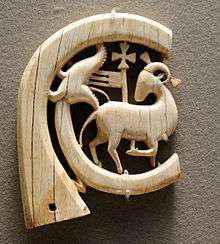Agnus Dei
Agnus Dei is the Latin name under which the "Lamb of God" is honoured within the Roman Catholic Mass and, by extension, other Christian liturgies descending from the Latin tradition. It is the name given to a specific prayer that occurs in these liturgies, and is the name given to the music pieces that accompany the text of this prayer.[1][2]

The use of the title "Lamb of God" in liturgy is based on John 1:29, in which St. John the Baptist, upon seeing Jesus, proclaims "Behold, the Lamb of God, who takes away the sin of the world!"
Liturgical usage
Roman Catholic
The Syrian custom of a chant addressed to the Lamb of God was introduced into the Roman Rite Mass by Pope Sergius I (687–701)[3][4] in the context of his rejection of the Council of Trullo of 692 (which was well-received in the Byzantine East), whose canons had forbidden the iconographic depiction of Christ as a lamb instead of a man.[5]
| Latin | English[6]:130 |
|---|---|
|
Agnus Dei, qui tollis peccata mundi, miserere nobis. Agnus Dei, qui tollis peccata mundi, miserere nobis. Agnus Dei, qui tollis peccata mundi, dona nobis pacem. |
Lamb of God, who takes away the sins of the world, have mercy upon us. Lamb of God, who takes away the sins of the world, have mercy upon us. Lamb of God, who takes away the sins of the world, grant us peace. |
The verse used in the first and second invocations may be repeated as many times as necessary.[7]
In a Tridentine Requiem Mass, the words "miserere nobis" are replaced by "dona eis requiem" (grant them rest), while "dona nobis pacem" is replaced by "dona eis requiem sempiternam" (grant them eternal rest).
The priest also uses the phrase "Lamb of God" again, later in the Mass. While displaying the Eucharistic species to the people before giving them Holy Communion, he says: "Ecce Agnus Dei, ecce qui tollit peccata mundi. Beati qui ad cenam Agni vocati sunt." ("Behold the Lamb of God, behold him who takes away the sins of the world. Blessed are those called to the supper of the Lamb.")[6]:132
Anglican
The following three versions are all found in the Church of England's Common Worship liturgical resources, and also in the Episcopal Church's liturgical resources:
Lamb of God, you take away the sin of the world, have mercy on us.
Lamb of God, you take away the sin of the world, have mercy on us.
Lamb of God, you take away the sin of the world, grant us peace.
O Lamb of God, that takest away the sins of the world, have mercy upon us.
O Lamb of God, that takest away the sins of the world, have mercy upon us.
O Lamb of God, that takest away the sins of the world, grant us thy peace.
Jesus, Lamb of God, have mercy on us.
Jesus, bearer of our sins, have mercy on us.
Jesus, redeemer of the world, grant us peace.
Lutheran
The version found in the Lutheran Service Book of the Lutheran Church–Missouri Synod is:
Lamb of God, You take away the sin of the world; have mercy on us.
Lamb of God, You take away the sin of the world; have mercy on us.
Lamb of God, You take away the sin of the world; grant us Your peace, grant us Your peace.
Musical settings
Religious music
Virtually every Mass setting (of which there are thousands) includes an Agnus Dei. Here are some examples:
- Machaut's Messe de Nostre Dame
- Bach's Mass in B minor
- Beethoven's Missa Solemnis
- Schubert's Mass No. 2
- Bob Chilcott's Little Jazz Mass
- Ralph Vaughan Williams's Mass in G minor
With a slightly changed text, the Agnus Dei is also part of musical settings composed for the Requiem Mass for the Dead. Such settings include:
- Mozart's Requiem
- Verdi's Requiem
- Fauré's Requiem
- Rutter's Requiem
- Britten's War Requiem, in which the text is interleaved with Wilfred Owen's poem "At a Calvary near the Ancre"
Some composers set the text as an independent movement, such as Samuel Barber, who wrote a version for his Adagio for Strings.
In popular culture
Outside of religious use, the text has been used by composers such as:
- Elliot Goldenthal for Alien 3
- Keiki Kobayashi for Ace Combat 04: Shattered Skies
- Elitsa Alexandrova for Assassin's Creed Rogue
- Enya for the song Trains and Winter Rains
- Halsey for the song Castle
- Kuroshitsuji (Black Butler) soundtrack for episodes 17 and 18
- Jon Bellion for Ooh
References
| Wikimedia Commons has media related to Agnus Dei (mass). |
- Randel, Don Michael (2003). The Harvard Dictionary of Music. p. 28. ISBN 0-674-01163-5.
- Atkinson, Charles Mercer (1975). The Earliest Settings of the Agnus Dei and Its Tropes. Chapel Hill: University of North Carolina. p. 14.
- Duffy, Eamon (2006). Saints & Sinners: A History of the Popes. Yale University Press. p. 84. ISBN 0-300-11597-0.
- Reader Daniel Lieuwen. "Lives of Orthodox Western Saints". McKinney TX: St Nicholas Orthodox Church.
- Ekonomou, Andrew J. (2007). Byzantine Rome and the Greek Popes: Eastern Influences on Rome and the Papacy from Gregory the Great to Zacharias, A.D. 590-752. Lexington Books. p. 223. ISBN 978-0-7391-1977-8.
- "The Order of Mass" (PDF). International Committee on English in the Liturgy, Inc. 2010. p. 130. Archived from the original (PDF) on 2012-03-19.
- General Instruction of the Roman Missal. §83.
The supplication Agnus Dei, is, as a rule, sung by the choir or cantor with the congregation responding; or it is, at least, recited aloud. This invocation accompanies the fraction and, for this reason, may be repeated as many times as necessary until the rite has reached its conclusion, the last time ending with the words dona nobis pacem ('grant us peace').
